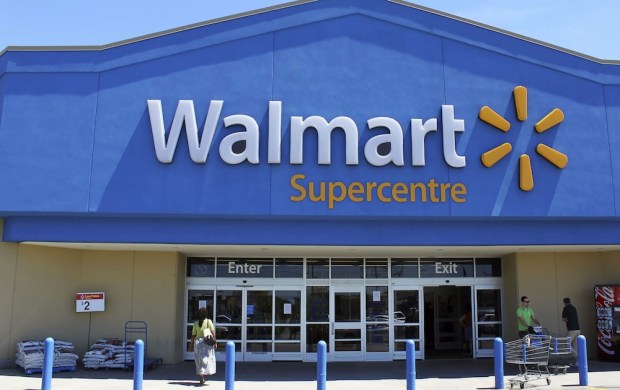Walmart’s Nimble Footed Sizzle, Digital Watches And Wall Street’s Watch Big Retail Fizzle

A 40 percent stock gain might be enough to garner a sizzle in any week, but Walmart has been firing on cylinders that extend well beyond earnings reports. When it comes to digital innovation, the company shows that big can also be nimble. Plus, luxury watches find a haven online, while Wall Street looks for retailers to be hit with a case of mall-aise.
Earlier in the millennium, there was a book titled, Who Says Elephants Can’t Dance? — a chronicle of IBM’s transformation from troubled business to tech behemoth.
That title has become a kind of shorthand for large firms that find a sustained way to be nimble in the face of challenges that demand transformation and rapid response to new threats. In the retail world, one pachyderm has been learning to dance in all manner of ways, displaying the chops to tango, watusi and foxtrot as situations demand.
Walmart is the elephant in the room for this week’s sizzle, boasting change that has become a constant. That sentiment was encapsulated in an interview with CEO Dough McMillon, who told TheStreet.com some eyes are opening on Wall Street, gazing at the retail behemoth through new lenses and pushing the stock up as much as 40 percent this year — with 10 percent gains coming last week in the wake of a stellar earnings report.
That’s enough for a sizzle in many respects. The bottom line can tell a lot about margins and strategy — namely, whether they’re working. Walmart’s latest number was $1 a share, edging the Street by three pennies.
But, other numbers matter in the retail world, and here is where there is steak with the sizzle. Same-store sales grew by 2.7 percent, better than expectations of 1.8 percent. Within the top line of $124 billion, eCommerce sales grew by 50 percent. Not a bad haul in a digital world where Amazon is, as always, a formidable foe.
The online growth spilled over into grocery, a category which showed the strongest momentum of all, as Sam’s Club sales excluding fuel were up 2.8 percent, and McMillon called out online grocery and free two-day shipping as lures for new customers.
Not bad for the old world, old school retailer, and evidence that the elephant can indeed dance. Walmart’s move into digital has been selective, as the company bought Jet.com last year and scaled a bit more with other companies added to its pantheon, including men’s clothier Bonobos.
Perhaps the hallmark of a true digital strategy is the offering of a payment method via mobile app, and isn’t that what Walmart Pay is all about? As PYMNTS research shows, as many as 50 percent of the retailer’s customers say they use that eponymous payment offering. That’s better than any other “Pays” we surveyed.
Speed is key, here, and it comes via the Mobile Express Returns program and where returns clock in at about 30 seconds. The company is building out a true commerce ecosystem across mobile in its flagship stores, where everything from gift cards to alerts on low(er) prices to peer-to-peer (P2P) money transfers can be tracked and transacted.
All in all, those who said Walmart was too slow of foot and too reliant on brick and mortar to join the digital age seem to have been thoroughly put in place. Elephants may be big and boxy but, then again, sometimes they can surprise with grace.
Sizzle
Small, but smart: Dollar Tree shows smaller can be better in retail. It grabbed an earnings beat, proving smaller store sizes and product assortments can be a nice combination, boosting same-store sales up 3.3 percent as foot traffic was up and people actually purchased in-store. A bit of an anomaly in retail lands, but it shows small formats can be nimble, too. Who says brick and mortar is dead?
Alibaba feasts on groceries: $2.9 billion investment snags a large stake in China’s biggest supermarket operator, where offline dominates as the preferred shopping method. The firm continued a multi-billion dollar investment spree in brick-and-mortar locations, where the format has proven sticky among buyers in a food sector that has been estimated to be worth as much as $500 billion.
Digital watches – of a different sort: We mean buying by bits and bytes, as the wristwatch makes the leap to cyberspace (of the buying and selling kind). Omega joins up with Panerai and others in a bid to buy time and offer consumers a way to buy timepieces. Might the clock be ticking on the traditional vendor model?
Fizzle:
Big retail now the big short: Some grinches on the Street are looking for mall-based retailers to falter and for their stocks to slip. Blame declining foot traffic and shuttering storefronts in the age of Amazon. Short-selling reached a two-year high, up 17 percent in the last month alone. Shares that sold short account for 17 percent of the float as Macy’s and Nordstrom’s similar tally is 12 percent of shares outstanding.
Young and hungry? Maybe not, as restaurant sales continue to slow and grocery sales are also relatively light. When it comes to eating out, the younger generation seems sated, as spending growth rates have gone from 9 percent year-over-year in 2015 to a relatively paltry 1.6 percent today. Spending on groceries is not gaining steam, as might be the logical case. Perhaps everyone is starving themselves in preparation for the holiday gluttony.
Nothing but (fake) nets: Alibaba co-founder Joe Tsai snaps up 49 percent of Brooklyn Nets NBA basketball team, while his company’s sites are rife with counterfeit gear sporting the — you guessed it — Nets. Oh, the irony.
